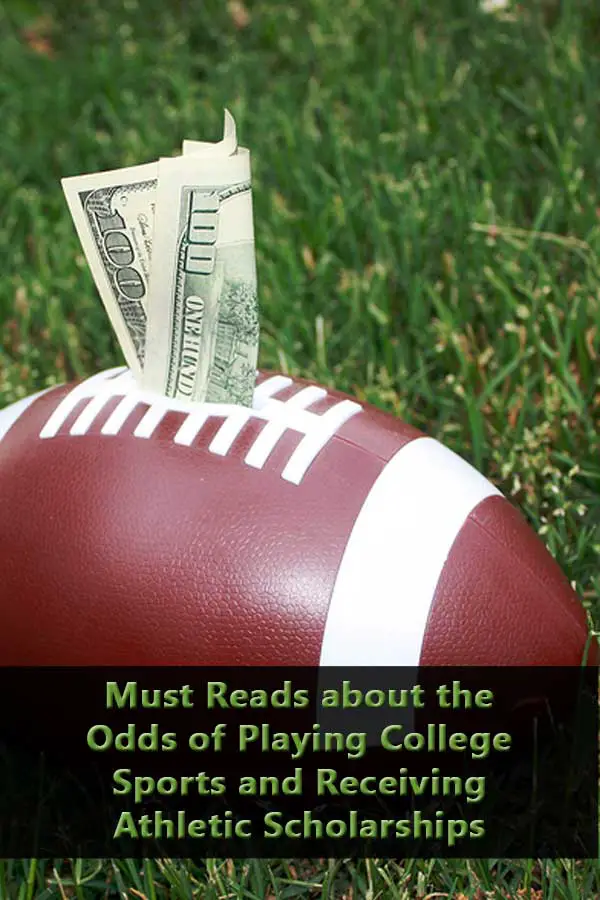 Just a casual browsing of my blog would reveal that I’m not anti-athlete. When my son wanted to play baseball in college, I spent a lot of time educating myself about the college baseball recruiting process and shared the information here. However, there’s a big difference between playing college sports and receiving an athletic scholarship.
Just a casual browsing of my blog would reveal that I’m not anti-athlete. When my son wanted to play baseball in college, I spent a lot of time educating myself about the college baseball recruiting process and shared the information here. However, there’s a big difference between playing college sports and receiving an athletic scholarship.
For those thinking that athletics are the key to paying for college, make sure you understand the reality of college athletics and the chances of actually receiving athletic scholarships. I think the following links combine to provide a good foundation for understanding the odds of playing college sports and the perils of receiving athletic scholarships.
Think athletic scholarships are a ‘holy grail’? Think again
CNBC presents the usual odds of playing college sports in an attention grabbing table. Of course, plenty of families will simply assume that their athlete will be the one that makes it. So the authors summarize
Put another way, the odds of landing a college scholarship in many major sports are lower than the chances of being admitted to Harvard, Yale, Princeton or Stanford.
The article also does a good job discussing the time demands and the injury issues.
Athletic Scholarships
This is a very short article by Mark Kantrowitz, THE financial aid expert. The reason to read is his conclusion that “… athletic scholarships are substituting for the need-based financial aid the student would otherwise have received.”
Expectations Lose to Reality of Sports Scholarships
This New York Time’s article was published in 2008 so the numbers are dated and there have been some rule changes. Still a very sobering look at college athletics:
Excluding the glamour sports of football and basketball, the average N.C.A.A. athletic scholarship is nowhere near a full ride, amounting to $8,707. In sports like baseball or track and field, the number is routinely as low as $2,000. Even when football and basketball are included, the average is $10,409. Tuition and room and board for N.C.A.A. institutions often cost between $20,000 and $50,000 a year.
Get your kids to play these sports to boost their chance at a college scholarship
This article seems like it should belong in the next section and in some way it does. It has some great graphics on the odds of playing in college and getting a scholarship but be sure to read it carefully. If the odds look too good to be true, they probably are because most athletes don’t compete in high school but on club teams.
Schools can give out 4-year athletic scholarships, but many don’t
With the rule changes, are colleges giving out more four-year scholarships? Who knows? When CBSSports.com asked 43 schools for information on scholarships, only 28 provided data. Yet, what comes across in the article from multiple coaches is that players are supposed to trust the coaches to do the “right thing.”
The Most Evil Thing about College Sports
More on the one-year athletic scholarship by Josh Levin. Make sure you check out all of the links.
To be clear, this new NCAA measure doesn’t require any school to give four-year scholarships–it merely gives them the option to do so. That makes the ‘no’ votes of Alabama, LSU, et al., even more appalling.
“No Athletic Scholarship for You, NEXT!” Meet the Scholarship Nazi.
Tom Swyers delivers the relevant information as the Soup Nazi in Seinfeld. What makes this worth reading is the information on merit scholarships at the end.
Athletic Scholarships and Financial Aid Issues
Some useful information on how an athletic scholarship can affect other scholarships a student might receive.
What Parents Should Think About Before Succumbing To College Sports Scholarship Dreams
This post in Forbes by Bob Cook is a basic warning to parents covering the usual reasons why their kids aren’t going to get a sports scholarship.
Still Interested?
For those still interested in playing college sports, make sure you approach the process realistically.
Colleges With the Most Athletes on Multi-Year Scholarships
Yes, athletes can get 4-year scholarships now–but only if the schools provide it. And if this list is an indication of the number of schools offering 4-year scholarships, there aren’t many. The seventh ranked school in the nation has only awarded 45 since 2011.
Are College Baseball Players Happy?
OK, this is one of my own posts. I’m referring to it because students need to understand how much time their sports will require in college. The focus is baseball but I include stats from other sports and links to the NCAA studies on student athletes. And this is just what they’re willing to release to the public.
Odds for an athletic scholarship don’t depend on participation numbers
This post provides a different perspective on the odds of getting a scholarship, specifically football. The take-away from this post is that it’s not impossible to get an athletic scholarship. However, it doesn’t say anything about the value of the scholarships. I see this more as an approach how to play sports in college rather than using it to justify shooting for an athletic scholarship.
Pac-12 study reveals athletes ‘too exhausted to study effectively’
Another article to read to make sure that you understand what you’re in for as an athlete. At the D1 level, “athlete” is the priority in “student-athlete.” Given that
Almost three-quarters (73 percent) said they felt a voluntary activity was considered mandatory. Some reported coaches threatening to “kick athletes off the team for missing voluntary activities.”
it’s no wonder the report wasn’t made public.
50 Critical Tips for Landing an NCAA Scholarship
I like this list because it gives a sense of the variables involved in playing college sports, much less receiving a scholarship.
How New NCAA Rules are Affecting Scholarship Offers
A short read on questions and issues athletes need to consider with the possibility of 4-year scholarships.
A Long Shot
Just because you play D1 in college doesn’t mean you’re going to go Pro.



Thanks so much Michelle…How I would love to get an audio message to play this in the ears of every high school athlete as they sleep at night.
Actually, I think it would do more good if the parents were the ones listening.